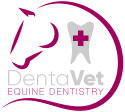Aging horses by their teeth
A horse’s age can be estimated by tooth eruption schedules, the amount of wear, and the changing anatomy of the teeth as they wear. A reasonable degree of accuracy exists up until the age of around 10 years, however after that it is best to talk in age groups of 5 or so years.
In the past it has been common to age horses by the appearance of their incisor teeth, however it is now known that this technique is inaccurate and can be unreliable.
Newborn to 5 years old
All teeth are normally erupted by the age of five but the actual age this occurs will depend on the individual horse, with certain breeds having different average eruption times. Between the ages of 2 and 5 years old a horse loses 24 deciduous teeth and erupts 36 – 44 permanent teeth.

5 to 10 years
Young permanent incisor teeth have deep hollow indentures in the centre of the occlusal (biting) surfaces, referred to as ‘cups’. Cups are commonly used to determine a horse’s age. Due to the natural wear pattern of the horse’s teeth these cups will wear down as the horse eats and although not completely accurate, the cups become smooth in the central lower incisors (#1) at around 6 years old, in the middle lower incisors (#2) around 7, in the corner lower incisors (#3) around 8, in the central upper incisors (#1) around 9, in the middle upper incisors (#2) around 10 and the corner upper incisors (#3) around 11 years of age.
As with aging through observing tooth eruption, this can be imprecise, and may be affected by breed variations, diet, by wearing a grazing muzzle, natural abnormalities, and vices such as cribbing.
10+ years
As the ‘cups’ disappear the central pulp cavity is exposed and the tooth becomes marked by a ‘dental star’ which is much smaller than the ‘cup’. The tip of the dental star first appears as a wide, thin yellow line in front of the cup. As the horse ages, dental stars appear darker, more rounded and in the centre of the tooth. Dental stars usually start to appear on the central lower incisors (#1) around 5 – 6 years of age. They appear on the middle incisors (#2) around 6 – 7 years and on the rest of the incisors between the ages of 8 – 12 years
As the horse ages, their teeth start to become longer and narrower. The angle of the incisors, when viewed from the side, becomes more acute and slanting forward. The occlusal surface of the incisors changes shape from elliptical to trapezoid to round and then triangular. The teeth become more stained and the colour changes from white to dark yellow.
Galvayne’s groove has traditionally been used as an age indicator in horses, however it is unreliable and inconsistent. It generally appears on the upper corner incisors around the age of 10, is approximately half way down the tooth at 15, and extends the full length of the tooth at 20. It then begins to disappear and will be half gone at 25, and completely gone near age 30.
